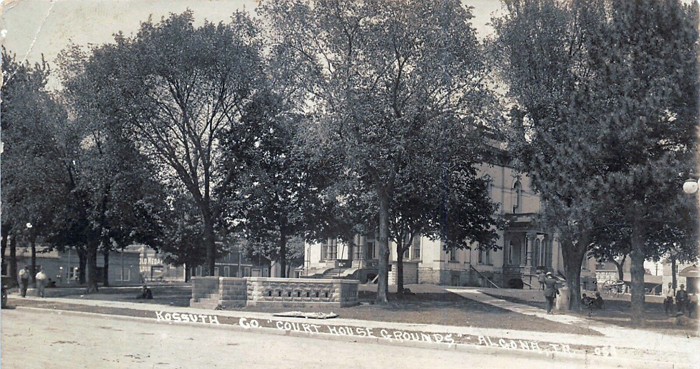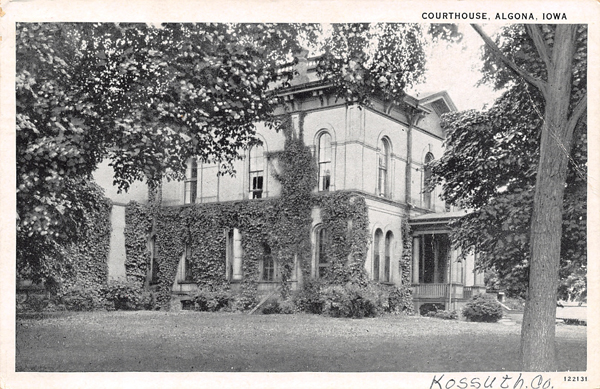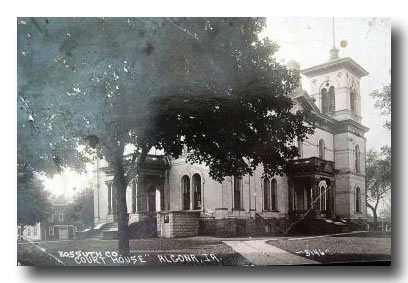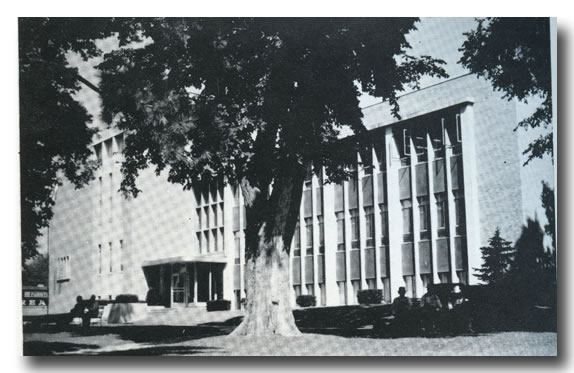Kossuth County Courthouse dedicated June 5, 1955, at Algona, IA.
The Counties and Courthouses of Iowa
By LeRoy G. Pratt
Copyright 1977, First Edition
KOSSUTH COUNTY (55)
Kossuth County, Iowa’s largest in area (979 square miles), was named for the Hungarian patriot, Lajos (Louis) Kossuth (1802-1894), whose zeal in the cause of liberty made him popular with people of the United States.
The first records of white men crossing the area included in present-day Kossuth County were the military expeditions of 1820, 1832, 1835, and 1844. At this time the trackless prairies and endless swamps supported an abundance of buffalo (bison), elk, prairie chickens, and waterfowl. Wolves howled at night, and the mosquitoes were almost unbearable.
Surveyors followed the military expeditions and established the state boundary between Iowa and Minnesota in 1852. The townships and sections were surveyed in 1854 and 1855. The swamps and sloughs in the region, together with the Indians and the grasshopper invasions, caused much trouble in these early years, prompting one of the engineers to state, “I would not give a jack knife for the whole county.”
The Third General Assembly of 1851 created or established 50 counties. When this session closed, every part of Iowa was included in some designated county for the first time. Kossuth County was one of those created by this wholesale legislation. At that time, it was the same size as other adjoining counties—about 24 miles square. Since there were few settlers in the county, it was attached to Boone County, and later to Webster County for election, revenue and judicial purposes. The present boundaries of Kossuth County are the same as fixed by the Legislature in January 1857—41 miles long and 24 miles wide. This came about by blotting Bancroft County (to the north) out of existence and adding it to Kossuth County. Then, in January 1870, Crocker County was created on the ruins of old Bancroft County, with Greenwood Center to be the new county seat. However, the Act creating Crocker County was declared by the court to be unconstitutional because the county did not contain 432 square miles of territory as required by the existing Constitution (although other counties with less than 432 square miles were established at the same time.) Thus Crocker County (which had been named to honor Brigadier General Marcellus M. Crocker) passed out of existence and its 12 townships were added to Kossuth County. This reduced the number of counties in Iowa from 100 (as shown on maps of the 1870s) to the present number, 99.
On July 9, 1854, two brothers, Asa C. Call and Ambrose A. Call, located on the ground where Algona now stands. At the time, the land was owned by the U. S. Government and was only partially surveyed. This work was subsequently finished by Cyrus C. Carpenter (1829-1898) who served two terms as Iowa’s eighth governor (1872-1876.) When the Call brothers arrived, they were the only white settlers on the Des Moines River north of Fort Dodge, but they were joined later in 1854 and early 1855 by other settlers who took out claims.
It was another 10 years or so after the land was surveyed before a permanent courthouse was erected in Kossuth County. Meanwhile, county officials used temporary quarters, including a log addition to the old St. Nicholas Hotel, which stood on what later became the site of the city hall. Records were kept in homes, or anywhere else that was convenient.
Early in 1866, supervisors asked for bids for a courthouse at Algona (originally known as Call’s Grove.) A small building was constructed by Samuel Reed, of Irvington, at a cost of $775. Lumber for the frame, two-story courthouse was hauled in wagons from the old town of Boonesboro, 90 miles away. Progress on the courthouse was constantly observed by “gratified spectators.” The building was completed and first occupied in January 1867. Six years later the building was sold to August Zahlten and moved to another location where it was used as a meeting hall and Sunday School.
In the meantime, at the June 1871 meeting of the board of supervisors, a resolution was passed calling for an election to vote on the erection of a new courthouse and the issuance of $25,000 in bonds, to bear interest at the rate of 10 per cent. A five mill levy was proposed to retire the bonds in installments of $3,000 each year. The election was held on October 10, 1871, and the proposal carried by a vote of 305 to 237. Opposition came from those citizens who hoped to change the location of the courthouse from the town square to another site.
The board of supervisors decided to be responsible for construction of the courthouse, using home mechanics and laborers. M. Mix was the architect. The project began in April 1872, when bids were received for basement grading and a contract was let at 12 ½ cents per cubic yard. This work was all done by hand shoveling and teams. Boulders dug out of the underlying glacial drift were used to build the foundation and basement. In many places the walls were over two feet thick. The jail was located in the basement.
About the time this work began, it was discovered that the county did not have clear title to the public square, which had been donated for an open park. So, on April 29, 1872, former County Judges Asa C. and Ambrose A. Call and their wives quit claimed their land rights to Kossuth County under the old county judge’s laws.
On July 4, 1872, a large crowd gathered for the laying of the courthouse cornerstone. There were appropriate ceremonies, including music by the Algona cornet band, and considerable oratory. Articles were placed in the cornerstone to be preserved.

Kossuth Co. "Court House Grounds" Algona, IA -- Vintage Postcards have been shared by Mr. David Shedlock, who has collected over the past years an awesome collection of IA picture postcards. (See the shared Shedlock Courthouse Pics directly "above & below") **The Postcard picture below -- Courthouse covered with living vines!**It must have been BEAUTIFUL.


Kossuth County Courthouse serving the county 1874-1953
This “stately edifice in the Anglicized Tuscan style of architecture” was first occupied in January 1874, and served the county until 1953. The two-story courthouse was 80’ x 53’, and of cut stone and Milwaukee brick construction, complete with a cornice extending around the building 42 feet above the ground, and topped with a graceful square tower. It was 92 feet to the top of the flagstaff—high enough that two were shattered by lightning. The courthouse lawn was beautified by setting out maples and elms around the building in April 1876. Until then, the public square was treeless.
By the time it was completed, the courthouse cost over $40,000. This had caused some of the citizens to accuse the board of supervisors of graft and fraud. The board then called for a complete investigation, which was conducted by three outstanding citizens. In their report at the July 1873 session of the board, they found no fraud or misapplication of county funds, and the board was exonerated. This did not end attempts to embarrass the board, however, for a grand jury indictment of the board and the construction agent was obtained in 1874. Trial was held at the April term of court, and a demurer to the indictment was sustained by the judge, to end the case.
At an election held September 9, 1947, a proposal to issue $500,000 in bonds to build a new courthouse carried by a vote of 1,693 to 856. Because of high building costs, construction of the new building was delayed and the bond money was invested to earn interest. Many new courthouses were visited by members of the board of supervisors and, in the spring of 1953, bids were obtained for the new building. Continued use of the old courthouse was not considered feasible, so it was torn down and county offices were moved to temporary quarters. Old timers stated that a quart of whiskey was inside the cornerstone, but when wreckers demolished the sturdy old building, none was discovered. The old cornerstone was preserved to display in the square, near the Civil War memorial.
The cornerstone of the present courthouse was laid August 16, 1953, with a crowd of 3,000 on hand. The building was occupied in February and March 1955, and was dedicated on June 5, 1955. Architects for the new courthouse were Dougher, Rich & Woodburn of Des Moines; the general contractor was Fagre Construction Co. of Estherville. The total construction cost was $520,605.32. Of modern design, and of reinforced concrete construction, the building is faced with light brick and is trimmed with stone. Elk horns, which graced the old courtroom, were moved to the new building. The horns were from the last elk shot in Kossuth County. The animal was shot in November 1867. Its horns may now be seen in the public assembly room on the first floor of the new courthouse [1977.]
All of Kossuth County was included in the Sioux Indian claim against the U.S. Government in connection with about 29 million acres of land ceded by Sioux Treaties from 1805-1858. Settlement of the claims was reached during the summer of 1967, after 16 years of litigation. The land, which was originally sold for 10 cents or less per acre, is located in parts of Minnesota, Iowa, South Dakota and Wisconsin. The amount agreed upon for five treaty claims totaled $12,250,000, based on the value of the land in the 1800’s. The money goes to the Sioux descendants enrolled on the tribal rolls.
The Sioux claimed that, in the early land sales, they were tricked and coerced into deals they did not understand, and that the U. S. Government did not abide by its treaty obligations. These early treaties, combined with crop failures of 1861, are cited by some historians as the primary cause of the bloody Sioux uprising of 1862, centered around New Ulm, Minnesota.
~Transcribed for posting by volunteer, Linda Ziemann.
Kossuth County Courthouse Today

~Above photograph by Linda Ziemann
IAGenWeb
*Last updated 7/3/2019
